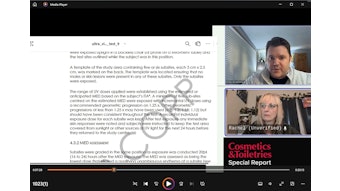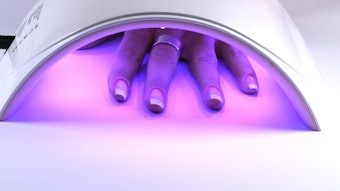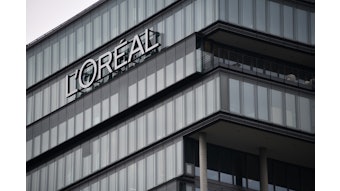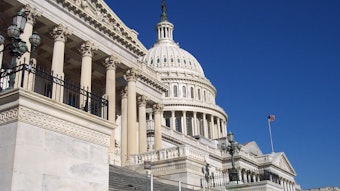
The Asia-Pacific region saw several significant regulatory developments from July to November 2024, related to everything from consumer rights protection law in China and risk assessment guidelines in Taiwan, to the first new ingredient registered under China's CSAR, South Korean labeling requirements, cosmetic ingredient updates in the Philippines and Thailand, foreign halal certification in Indonesia, and more. The present article offers a recap of these key changes.
This article is only available to registered users.
Log In to View the Full Article
The Asia-Pacific region saw several significant regulatory developments from July to November 2024, related to everything from consumer rights protection law in China and risk assessment guidelines in Taiwan, to the first new ingredient registered under China's CSAR, South Korean labeling requirements, cosmetic ingredient updates in the Philippines and Thailand, foreign halal certification in Indonesia, and more. The present article offers a recap of these key changes.
China: Consumer Rights Protection Law
On March 15, 2024, China released a decree that introduced the updated version of the National Law on the Protection of Consumer Rights and Interests.1 These regulations, which took effect on July 1, 2024, outline specific responsibilities for business operators. They include ensuring the safety of consumers' personal and property rights, addressing defective products, preventing misleading advertisements, maintaining price transparency, guaranteeing product quality, protecting consumers’ personal information and safeguarding the rights and interests of elderly individuals and minors as consumers.
Overall, these regulations represent a step toward strengthening consumer rights in China, promoting ethical business practices and fostering trust between consumers and businesses.
China: Technical Guidelines for Safety Assessment
On July 8, 2024, the China National Institutes for Food and Drug Control (NIFDC) issued2, 3 the finalized guidelines, accompanied by Q&As,4-7 following a public consultation launched on April 10, 2024.8 These guidelines encompass stability testing, preservative challenge testing, packaging compatibility testing and skin sensitization testing, offering comprehensive guidance on the safety assessment of cosmetics and their ingredients.
The four technical guidelines are as follows.
- Technical Guidelines for Stability Testing and Assessment of Cosmetics:9 Assess the quality changes of cosmetics under different conditions using influencing factors and accelerated and long-term tests, ensuring samples and conditions align with marketed products.
- Technical Guidelines for Preservative Challenge Testing and Assessment of Cosmetics:10 Evaluate the effectiveness of cosmetic preservatives, allowing the use of existing data for similar formulations and preservative systems.
- Technical Guidelines for Compatibility Testing and Assessment of Cosmetics with Packaging Materials:11 Assess the interaction between cosmetics and packaging materials, performing compatibility tests if potential risks are identified.
- Technical Guidelines for Integrated Approaches to Testing and Assessment (IATA) of Skin Sensitization:12 Use a “2 out of 3” integrated testing strategy (ITS) with alternative methods to evaluate the allergenic potential of cosmetic ingredients, ensuring clear data interpretation and uncertainty analysis.
Overall, these updates help to standardize safety assessments across the industry, improve product quality and ensure that cosmetic products undergo necessary testing before reaching consumers. These measures foster a safer and more transparent cosmetic industry, benefiting both manufacturers and consumers by reducing risks and building trust in product safety.
China: Digital Submission of Registration/Notification Materials
On July 8, 2024, China’s National Medical Products Administration (NMPA) announced13 the full implementation of electronic submissions for cosmetic products and new cosmetic ingredient (NCI) registrations and notification materials, effective Sept. 1, 2024. Chinese domestic registrants, notifiers, responsible persons and manufacturers shall submit their materials electronically, with paper documents no longer necessary. NMPA and provincial departments will continue to optimize their procedures to align with these new requirements.
The shift to electronic submissions for cosmetic products and new cosmetic ingredients in China indicates a step forward in modernizing and improving the regulatory environment for cosmetic products, which allows for quicker processing of applications, thereby improving the overall effectiveness of the regulatory system.
China: Cosmetic Risk Monitoring
On Sept. 14, 2024, China NMPA released14 the draft, “Administrative Measures on Cosmetic Safety Risk Monitoring,”15 for public comment. The measures aim to enhance cosmetic safety risk monitoring, replacing the previous “Working Rules for Cosmetic Risk Monitoring”16 from January 2018. The draft document, consisting of 30 articles across six chapters, covers general provisions, plan formulation, sampling and inspection, investigation and handling, application of monitoring results and supplementary provisions.
The key points of this draft are as follows.
- Responsibility divisions and monitoring objectives: The goal of risk monitoring is to identify and manage risks to cosmetic safety, helping to develop control measures and improve standards.
- Medical Products Administration (MPA): Manages national risk monitoring, establishes the monitoring system and sets the overall plan.
- Local MPAs: Conduct monitoring at administrative levels to identify risks.
- Key monitoring products and items: Risk monitoring focuses on widely used cosmetics with high risks, prioritizing substances that pose health threats, affect vulnerable groups or are linked to regulatory concerns, production processes or the development of new standards.
- Risk monitoring process: The draft measures detail the risk monitoring process, which includes the following steps: sampling, inspection and testing, result reporting, investigation and handling, risk control and case filing.
- Application of monitoring results: MPAs will implement tailored risk management actions based on specific situations, including continuing data collection, enhancing communication, revising standards or developing new testing methods, depending on the identified risks and circumstances.
The draft measures highlight the ongoing commitment to ensuring cosmetic safety through a dynamic, evidence-based approach to risk monitoring. By continually updating safety standards, responding to identified risks and fostering collaboration across government and industry, the NMPA aims to create a safer and more transparent market for consumers, while also encouraging innovation and accountability within the cosmetic industry.
China: Cosmetics Inspection Regulation
On Oct. 19, 2023, China’s NMPA sought public opinions17 on the Administrative Measures on Cosmetics Inspection.18 The finalized version of these measures was released on April 29, 2024, and came into effect on Nov. 1, 2024. This is the first comprehensive effort by NMPA to standardize cosmetics inspections since the Cosmetic Supervision and Administration Regulation (CSAR).19 The measures, consisting of eight chapters and 47 articles, provide detailed guidance on inspection categories, procedures the connection between inspections and audits, and the handling of results. The goal is to address existing challenges in cosmetics inspections.
The key points of the measure are as follows.
- Applicable scope: The measures cover the following areas: 1) registration and notification of cosmetic products and new cosmetic ingredients (NCIs); 2) notification of toothpaste and new toothpaste ingredients; 3) inspections of suppliers and manufacturers of cosmetic ingredients and primary packaging materials; and 4) production and operation of toothpaste.
- Inspection categories and requirements: Cosmetic inspections are divided into four types, each with specific requirements.
- Licensing inspection: Conducted during the licensing process to ensure compliance with legal requirements for issuing, renewing or changing production licenses.
- Routine inspection: Scheduled inspections to assess compliance with laws, regulations and standards, targeting cosmetics such as children’s products and special cosmetics.
- Cause-based inspection: Initiated by risk information or reports indicating potential quality and safety issues. This can include complaints, adverse reactions or risk monitoring.
- Other inspections: Inspections that do not fall into the above categories but are necessary for regulatory purposes.
The implementation of the measures is expected to strengthen the cosmetics regulation by providing clear, standardized inspection procedures to ensure greater transparency. It enhances consumer safety by targeting high-risk products and addressing potential safety issues through tailored inspections. Additionally, it promotes industry compliance, helping manufacturers and suppliers adhere to regulations and improving overall product quality.
China: Safety and Technical Standards Amendments
On Oct. 30, 2024, China NMPA announced to make amendments20 to the Safety and Technical Standards for Cosmetics (STSC, 2015 edition).21 These amendments introduce three new testing methods and revise two existing ones for cosmetic registration, notification and sampling, effective July 1, 2025.
The three new testing methods are:
- Determination of Azelaic Acid and its Salts in Cosmetics,
- Determination of Phenacetin in Cosmetics and
- Determination of Hydroxycapric Acid in Cosmetics.
The two revised methods are:
- Determination of Asbestos in Cosmetics and
- Determination of Glucuronic Acid and Other 13 Kinds of Components in Cosmetics.
China: The First Registered Ingredient Under the CSAR
On Nov. 4, 2024, China NMPA approved22 the registration of a new cosmetic ingredient, isobutylamide thiazole resorcinol (Thiamidol 630, Beiersdorf), as a whitening agent for leave-on cosmetics (excluding products that may pose an inhalation risk).
The approval of isobutylamide thiazole resorcinol is seen as a significant milestone in the registration and notification process for new cosmetic ingredients since it is the first ingredient to be registered under the CSAR framework since 2021. This development is expected to boost the R&D efforts of cosmetic companies and foster innovation in cosmetic ingredients.
China: Ingredient Usage Information
On Nov. 15, 2024, China’s NIFDC released a notice23 for public consultation on the draft of “Ingredient Usage Information of Marketed Products.”24 This draft is part of a series of technical documents aimed at enhancing cosmetic safety assessments by guiding companies in using existing ingredient data. The revised draft expands the ingredient list from 2,234 to 3,578 and increases ingredient usage information to 5,240 items, with a notable rise in plant-based extracts. It also raises permissible usage concentrations for several ingredients, allowing broader applications in cosmetics.
The expanded ingredient list and revised usage concentrations allow for more flexibility in product formulations, particularly benefiting companies using plant-based extracts. This update also promotes transparency in the cosmetic industry, supporting better safety assessments and helping to ensure that compliant, well-assessed ingredients are used in consumer products.
Taiwan: Cosmetic Regulation Repeals
On March 28, 2024, the Taiwan Food and Drug Administration (TFDA) announced its intention25 to repeal five regulations and implement a new regulation in response to the discontinuation of the product category of specific purpose cosmetics. On July 1, 2024, TFDA subsequently approved the repeal of four regulations26-29 on specific-purpose cosmetics.
The repealed regulations include the following.
- Regulations for Issuance of Permit License of Specific Purpose Cosmetics30
- Regulation for Authorizing the Applications of Import of Non-licensed Specific Purpose Cosmetics31
- Import Limits for Personal Use Specific Purpose Cosmetics Exempted from Inspection and Registration32
- Particulars of Specific Purpose Cosmetics that May Be Voluntarily Modified33
Taiwan: Risk Assessment Guidelines
On Nov. 8, 2024, Taiwan’s TFDA updated34 the Guidelines for Risk Assessment of Cosmetics with Nanomaterials35 initially introduced in July 2015. The updated guidelines primarily revise the assessment criteria for cosmetics containing nanomaterials, focusing on two key areas: physical and chemical property analysis, and safety evaluation. Unlike the previous version, which covered both nanomaterials and finished products, the revised guidelines now concentrate solely on nanomaterials and introduce four additional assessment items. Additionally, the definition of cosmetics and referenced documents were updated to align with current standards.
The updated guidelines provide more focused and detailed criteria for evaluating the safety of cosmetics containing nanomaterials, ensuring better regulatory alignment and enhanced consumer protection.
Japan: Wrinkle Improvement Advertising
On Aug. 30, 2024, the Japan Cosmetic Industry Association (JCIA) released36 new guidelines for advertising quasi-drugs claiming wrinkle improvement. The guidelines stress the need for clear and accurate representation of approved claims.
The key points include:
- Clear representation: Advertisements must accurately reflect the approved efficacy of wrinkle improvement. Terms like for wrinkles may mislead consumers about the product’s benefits and should be revised.
- Prohibited claims: Any explanations related to wrinkle grading or efficacy tests are not allowed, as these imply guarantees of effectiveness.
- Age-related claims: While age-related wrinkle improvements can be advertised, claims of rejuvenation or aging prevention are prohibited.
- Factual claims: Claims about the degree of improvement must be factual. Specifically, references to deep wrinkles are not permitted, as such improvements are not clinically recognized.
- Mechanism of action: Explanations of how effective ingredients work must align with approved application materials to avoid misleading consumers about efficacy claims.
Additionally, JCIA has provided prior guidelines on cosmetic advertising, offering insights into aging care claims, which can help importers navigate compliance in the Japanese market. By emphasizing accuracy and transparency, these guidelines protect consumers from misleading or exaggerated claims and maintain trust in cosmetic products.
South Korea: Labeling Requirements
On Jan. 31, 2024, the Ministry of Food and Drug Safety (MFDS) proposed to amend the Enforcement Rule of the Cosmetics Act37 aimed at strengthening labeling requirements for special cosmetics, thereby enhancing consumer safety. After a six-month review period, the revised rule was officially published on July 9, 2024.
The key amendments are as follows.
- Enhanced cosmetic labeling standards: Previously, small-volume cosmetics only required essential information (product name, business name, expiry date, etc.) due to limited labeling space. The new rule mandates that special cosmetics, such as external genital cleansers and eyelash perm wave products, must include ingredient lists and precautions, regardless of volume.
- Use of certification results from private institutions: The previous regulation restricted advertising to certification results from MFDS-delegated institutions. The amendment allows the use of certification results from private institutions for advertising purposes.
- Streamlined administrative measures: The regulation establishes a procedure for directly reporting resignations to the local food and drug administration when a responsible sales manager or custom cosmetic manufacturing manager resigns. This facilitates smoother registration for a new position in a different company.
These updates, which took effect on July 9, 2024, enhance consumer safety while improving regulatory transparency and operational efficiency. Notably, the labeling requirements for small-volume cosmetics will be enforced one year later. The revision also led to the repeal of the Regulation on the Authentication of Liability of Certification Assurance Institutions for Cosmetic Labelling and Advertisements38 on July 9, 2024.
South Korea: Ingredient Updates
On Aug. 2, 2024, the MFDS issued a notice inviting public feedback on changes to the Cosmetic Safety Standard.39 The agency proposed to add one new UV filter, remove one existing UV filter, and tighten the usage limits for six restricted ingredients.
The main revisions include the following.
- Removed UV filter: Compounds of lawsone and dihydroxyacetone
- Added UV filter: Tris-biphenyl triazine
- Six restricted ingredients: 2,6-Dihydroxyethylaminotoluene, benzophenone-3 (oxybenzone), nonoxynol-9, butylphenyl methylpropional, cyclosiloxane (D4) and cyclopentasiloxane (D5)
The changes are to take effect six months after the official publication of the regulation. Businesses will be allowed a two-year grace period to sell cosmetics that were manufactured or imported before the enforcement of the new regulation. Notably, companies producing products with D5 will receive an extended grace period of three years to formulate alternative ingredients.
South Korea: Enforcement Rule of the Cosmetics Act
On Sept. 24, 2024, the MFDS released a draft of the Enforcement Rule of the Cosmetics Act40 for public consultation. The proposed changes aim to create exceptions for labeling on cosmetic packaging, prohibit misleading advertising and enhance administrative provisions.
The key proposals are as follows.
- Labeling exceptions for transparent packaging: The draft allows cosmetics in transparent boxes or films to be exempt from including expiration dates and other labeling information on their external packaging, as this information can be easily confirmed.
- Prohibition of misleading advertising: New provisions will ban labeling and advertising that imply unsafe uses (e.g., injecting into the body or applying to wounds). MFDS proposes penalties for violations, including sales suspension and business registration cancellation after repeated offenses.
- Application process for lifting ingredient restrictions: Manufacturers will be permitted to apply for lifting prohibitions on certain ingredients, with a process aligned with existing procedures for modifying usage standards for restricted substances.
- Legal basis for online certificate issuance: The draft introduces a legal framework for the online issuance of business registration certificates and functional cosmetic evaluation results, streamlining the certificate issuance process for easier access and management by applicants.
South Korea: Labeling Standards
On Sept. 24, 2024, the MFDS released an updated version of the Regulation of Labelling Cosmetics Precautions for Use and Fragrance Allergens,41 effective immediately. These updates focus on small-packaged cosmetics and eyelash perm products. Notably, the provision for small-packaged cosmetics will be enforced starting July 10, 2025.
Key updates include:
- Specifying new requirements for small-packaged cosmetics: Cosmetics such as external genital cleansing agents and eyelash perm products with a volume of more than 10 mL(g) but less than 50 mL(g) shall include all required labeling items as per Article 10 of the Cosmetics Act.42
- Establishing precautions for eye-lash permanent wave: The regulation introduces specific precautions for eyelash perm products, including:
- Avoiding self-use if possible;
- Following the prescribed usage and dosage;
- Avoiding eye contact, rinsing immediately if the product contacts the eyes or face;
- Avoiding use in individuals with certain health conditions, during menstruation or post-childbirth;
- Keeping out of the reach of children, storing in a cool, dark place below 15°C and not using if the product changes color or has precipitates; and
- Discarding opened products immediately after use (except for containers that prevent air exposure during use).
By providing clearer labeling requirements for small-packaged cosmetics and establishing specific precautions for more sensitive products like an eye-lash permanent wave, the regulation helps to reduce misuse and protect consumers from harm.
Thailand: Cosmetic Ingredient Updates
On July 3, 2024, the Thai Food and Drug Administration (Thai FDA) announced updates43-45 to Thailand’s cosmetic ingredient lists. These changes align with revisions to the ASEAN Cosmetic Directive, as agreed upon during the 38th ASEAN Cosmetic Scientific Body (ACSB) Meeting.46 The new amendments will come into effect on July 4, 2024.
The main amendments include:
- Adding two ingredients.
- Adding the new entry: N, N-diethyl-m-toluamide (diethyltoluamide (DEET); CAS NO. 134-62-3/26545-51-7) into the List of Prohibited Ingredients;47 and
- Adding the new entry: bis-(diethylaminohydroxybenzoyl benzoyl) piperazine (CAS NO. 919803-06-8) including its nano form, in the List of Permitted Sunscreen.48
- Revising one ingredient: Revising the use requirements for the permitted colorant CI 45430 (16423-68-0/12227-78-0) in the List of Permitted Colorants.49
Thailand: Labeling Requirements
On Aug. 5, 2024, the Thai FDA issued a draft notification for public consultation50 concerning revisions to warning labels on cosmetics that include climbazole as a preservative.
Key proposed amendments include the following.
- Removal of the age restriction: The phrase “do not use in children under 6 years of age” will be removed.
- Modification of warning text: The warning will be updated from, “if irritation or abnormality occurs, stop using and consult a doctor or pharmacist,” to “if irritation occurs after using the product, stop using and consult a doctor or pharmacist.”
- Eliminating the notes section: Climbazole is specified only for hair, eyebrow, mustache and beard products (excluding eyelashes and facial skin), making additional notes unnecessary.
After finalization, the notification will take effect the day following its publication. Stakeholders with products that currently meet the labeling standards for climbazole will have a 180-day grace period to adjust to the new requirements.
Thailand: Intimate Product Requirements
On Sept. 24, 2024, the Thai FDA released an updated standard titled, “Guidelines for Evaluating the Notification of Products Used in Intimate Areas (Revised Edition July 2024).”51 This revised edition follows the updates made to the “Criteria for Reviewing Notification of Products Used in Intimate Areas”52 in April 2024.
The new guidelines build upon the previous April 2024 version while preserving the overall structure, which includes definitions, formulations, efficacy claims, naming rules and documentation requirements. Notably, the revised edition introduces additional provisions concerning physical characteristics, product formulations and naming regulations for intimate products.
Thailand: Cosmetic Standards Updates
On Oct. 1, 2024, Thailand’s Ministry of Industry published eight new voluntary Thai Industrial Standards Institute (TIS) standards for cosmetics, effective from Oct. 2, 2024. These standards address key aspects of cosmetic safety and quality, encompassing microbiological testing, analytical methods, sun protection evaluation, as well as natural and organic cosmetic ingredients.
The eight approved standards are as follows.
- TIS 3794-2567 (2024) Cosmetics - Microbiology - General Instructions for Microbiological Examination53
- TIS 3795-2567 (2024) Cosmetics - Microbiology - Microbiological Limits54
- TIS 3796-2567 (2024) Cosmetics - Microbiology - Detection of Specified and Non-Specified Microorganisms55
- TIS 3797-2567 (2024) Cosmetics - Analytical Methods - Nitrosamines: Detection and Determination of N-Nitrosodiethanolamine (NDELA) in Cosmetics by HPLC, Post-Column Photolysis and Derivatization56
- TIS 3798-2567 (2024) Cosmetics - Analytical Methods - Validation Criteria for Analytical Results Using Chromatographic Techniques57
- TIS 3799-2567 (2024) Cosmetics - Analytical Methods - Nitrosamines: Detection and Determination of N-Nitrosodiethanolamine (NDELA) in Cosmetics by HPLC-MS-MS58
- TIS 3800-2567 (2024) Cosmetics - Sun Protection Test Methods - Water Immersion Procedure for Determining Water Resistance59
- TIS 3801 Volume 1-2567 (2024) Guidelines on Technical Definitions and Criteria for Natural and Organic Cosmetic Ingredients and Products - Part 1: Definitions for Ingredients60
Philippines: Cosmetic Ingredient Updates
On Oct. 10, 2024, the Philippines Food and Drug Administration (FDA) introduced61 revised amendments to the ingredient annexes to the ASEAN Cosmetic Directive (ACD).62 These amendments, which were adopted during the 39th ASEAN Cosmetic Scientific Body (ACSB) meeting, primarily include the following.
- Annex II — List of prohibited ingredients: Revising the requirements for one prohibited ingredient: N,N-diethyl-m-toluamide/diethyltoluamide (DEET), CAS No. 134-62-3, 26545-51-7.
- Annex III — List of restricted ingredients: Adding one restricted ingredient: acid yellow 3, CAS No. 8004-92-0; and revising the requirements for three restricted ingredients:
- Benzoic acid, 2-hydroxysalicylic acid, CAS No. 69-72-7;
- Pyrithione zinc zinc pyrithione, CAS No. 13463-41-7; and
- Ammonium silver zinc aluminum silicate, CAS No. 130328-20-0.
- Annex VI — List of permitted preservatives: Revising the identification of nine permitted preservatives (see Updates to ASEAN Cosmetic Directive (ACD)’s Ingredient Annexes: 15 Revised and 1 Added for full details).
- Annex VII — List of permitted UV filters: Revising the identification of two permitted UV filters:
- 3,3-(1,4-Phenylenedimethylene) bis(7,7-dimethyl-2-oxo-bicyclo-[2,2,1]hept-1-yl methanesulfonic acid) and its salts; terephthalylidene (CAS No. 92761-26-7)/dicamphor sulfonic acid (CAS No. 90457-82-2).
- 2-Hydroxy-4-methoxybenzophenone-5-sulfonic acid (benzophenone-4) and its sodium salt (benzophenone-5); benzophenone-4 CAS No. 4065-45-6/benzophenone-5 CAS No. 6628-37-1.
On July 1 and July 9, 2024, Singapore and Vietnam63 also adopted the updated ingredient annexes to remain aligned with the ASEAN Cosmetic Directive (ACD).
Indonesia: Foreign Halal Certificate Registration
On July 15, 2024, the Indonesia Halal Product Guarantee Agency (BPJPH) announced64 the launch of the Foreign Halal Certificate Registration (RSHLN) channel on the Halal Information System (Sihalal), streamlining the process for halal product trade in Indonesia.
This initiative, mandated by the Halal Product Assurance Law,65 enables foreign halal products with existing halal certificates from recognized Overseas Halal Institutions (LHLNs) to enter Indonesia without needing new certifications. However, it is essential for these halal certificates to be registered with BPJPH prior to the distribution of the products in Indonesia. BPJPH currently recognizes 37 LHLNs from 16 countries/regions.
Indonesia: Labeling Requirements
On Aug. 29, 2024, Indonesia released an amended draft of the Regulation Concerning Cosmetic Labeling, Promotion and Advertising for public consultation.66 This revised draft incorporates corporate obligations and supervision requirements for labeling, promotion and advertising outlined in the Technical Requirements for Cosmetic Labeling,67 Technical Guidelines for Cosmetics Advertising,68 as well as the Regulation for Supervision on Manufacture and Circulation of Cosmetics.69
The amendments primarily focus on the following key aspects.
- Mandatory labeling items: Newly specifying the mandatory labeling items for refillable cosmetics, including cosmetics name, batch number, expiration date, notification number, name and address of cosmetic refill facility and refilling date.
- Extended labeling scope: Expanding the labeling requirements to encompass refillable cosmetics. Labels must ensure completeness, objectivity, non-misleading information, no claims of drug status, clarity, readability and durability once the amendment is officially released.
- Enhanced labeling standards: Introducing additional detailed requirements to enhance the overall labeling standards.
- Promotion clarity: Clarifying the form and implementation of cosmetics promotion.
- Advertisement supervision: Adding supervision methods for cosmetic advertisements.
This revision is intended to improve cosmetic labeling regulation, thereby ensuring consumer safety. These revisions are currently in draft form and have not yet been implemented. Once finalized, it is expected that the government will provide a transition period for businesses to adapt to these changes.
Indonesia: GMP Certificate Application and Renewal
On Nov. 5, 2024, the Indonesia Food and Drug Supervisory Agency (BPOM) released a draft of Technical Requirements for Cosmetic Good Manufacturing Practices (GMP) Certification for public consultation.70
The key proposed amendments are as follows.
- Changes to required documents and the verification period for application submissions.
- Revised requirements for GMP certificate renewal, including:
- The GMP certificate and GMP fulfillment certificate are valid for five years, with renewal applications now due six months before expiration instead of three. Applications submitted after this deadline require a new certificate.
- For Class A GMP fulfillment certificates, the current process allows for twice renewals, but the draft proposes limiting this to one time.
- Facility inspections will be mandatory for renewals if there are changes in production capacity, additional rooms or cleanliness levels. New provisions specify scenarios where inspections are not needed during renewal.
- And the requirement of BPOM to verify renewal application letters within three working days has been removed.
Vietnam: Stronger Cosmetic Enforcement
On Sept. 19, 2024, the Drug Administration of Vietnam (DAV) issued a letter71 to provincial and municipal health departments, calling for stronger enforcement of cosmetic regulations to address non-compliance.
The DAV outlined three key actions for provincial and municipal health departments:
- Strengthening cosmetic inspections throughout production and trade;
- Collaborating with local authorities to monitor the marketplace, especially online and in social media; and
- Enforcing strict penalties on violators.
These steps are designed to enhance cosmetic management and quality, protect consumer health, and ensure that products in the market meet the necessary safety and quality standards.
India: Cosmetics Registration and Import Process
On Aug. 9, 2024, India’s Central Drugs Standard Control Organization (CDSCO) announced72 an update to its cosmetics registration and import process. Effective Aug. 16, 2024, the Sugam online portal now limits cosmetic product submissions to a maximum of 50 per application. However, companies can submit multiple applications.
This change, intended to streamline the registration and import process, improve efficiency and ensure compliance with the six-month processing timeframe mandated by the Cosmetics Rules, 2020, may necessitate adjustments in cosmetics companies’ application strategies and is expected to lead to faster processing and more efficient regulatory compliance.
Conclusion
In summary, recent regulatory updates across the Asia-Pacific region demonstrate a concerted effort to enhance the cosmetics regulatory framework and strengthen oversight, ultimately aiming to improve product quality and safeguard consumer safety. Cosmetic stakeholders must stay informed about relevant regulations, conduct timely safety assessments of their products, and actively collaborate with regulatory authorities for future reviews and compliance.
References
1. The State Council of the People’s Republic of China. (2024, Mar 15). Regulations for the Implementation of the National Law on the Protection of Consumer Rights and Interests. Available at: https://www.gov.cn/zhengce/content/202403/content_6940158.htm
2. China National Institutes for Food and Drug Control (NIFDC). (2024, Jul 8). Notice on Releasing Three Technical Guidelines Including Technical Guidelines for Cosmetics Stability Testing and Assessment. NIFDC. Available at: https://www.nifdc.org.cn/nifdc/bshff/hzhpbzh/hzhpbzhtzgg/202407081945531149288.html
3. NIFDC. (2024, Jul 8). Notice on Releasing Technical Guidelines for Integrated Approaches to Testing and Assessment (IATA) of Skin Sensitization. Available at: https://www.nifdc.org.cn/nifdc/bshff/hzhpbzh/hzhpbzhtzgg/202407081945531149287.html
4. NIFDC. (2024, Jul 8). FAQ on NIFDC’s Notice on Releasing Three Technical Guidelines Including Technical Guidelines for Cosmetics Stability Testing and Assessment. Available at: https://www.nifdc.org.cn/nifdc/xxgk/ggtzh/tongzhi/20240410104834134.html
5. NIFDC. (2024, Jul 8). NIFDC’S FAQ on Technical Guidelines for Cosmetics Preservative Challenge Testing and Evaluation. Available at: https://www.nifdc.org.cn/nifdc/bshff/hzhpbzh/hzhpbzhtzgg/202407081945531149285.html
6. NIFDC. (2024, Jul 8). NIFD’S FAQ on Technical Guidelines for Compatibility Testing and Evaluation of Cosmetics with Packaging Materials. Available at: https://www.nifdc.org.cn/nifdc/bshff/hzhpbzh/hzhpbzhtzgg/202407081945531149284.html
7. NIFDC. (2024, Jul 8). NIFDC’S FAQ on Technical Guidelines for Integrated Approaches. Available at: https://www.nifdc.org.cn/nifdc/bshff/hzhpbzh/hzhpbzhtzgg/202407081945531149283.html
8. NIFDC. (2024, Apr 10). Notice on Publicly Soliciting Opinions on Technical Guidelines for Cosmetic Stability Testing and Other Documents. Available at: https://www.nifdc.org.cn/nifdc/xxgk/ggtzh/tongzhi/20240410104834134.html
9. ChemLinked. (2024, Jul 8). Technical Guidelines for Stability Testing and Assessment of Cosmetics. Available at: https://cosmetic.chemlinked.com/database/view/1802
10. ChemLinked. (2024, Jul 8). Technical Guidelines for Preservative Challenge Testing and Assessment of Cosmetics. Available at: https://cosmetic.chemlinked.com/database/view/1804
11. ChemLinked. (2024, Jul 8). Technical Guidelines for Compatibility Testing and Assessment of Cosmetics with Packaging Materials. Available at: https://cosmetic.chemlinked.com/database/view/1806
12. ChemLinked. (2024, Jul 8). Technical Guidelines for Integrated Approaches to Testing and Assessment (IATA) of Skin Sensitization. Available at: https://cosmetic.chemlinked.com/database/view/1808
13. National Medical Products Administration (NMPA). (2024, Jul 8). Announcement on the Full Implementation of Electronic Materials for Cosmetics and New Cosmetic Ingredients Registration and Notification (No. 91 of 2024) NMPA. Available at: https://www.nmpa.gov.cn/xxgk/ggtg/hzhpggtg/jmhzhptg/20240708171629190.html
14. NMPA. (2024, Sep 14). Announcement on the Draft of Administrative Measures on Cosmetic Safety Risk Monitoring. Available at: https://www.nmpa.gov.cn/xxgk/zhqyj/zhqyjhzhp/20240914105310184.html
15. ChemLinked. (2024, Sep 14). Administrative Measures on Cosmetic Safety Risk Monitoring (Draft for Comments). Available at: https://cosmetic.chemlinked.com/database/view/1870
16. ChemLinked. (2018, Jan 9). Administrative Measures on Cosmetic Safety Risk Monitoring (Draft for Comments). Available at: https://cosmetic.chemlinked.com/database/view/1869
17. NMPA. (2024, Oct 19). China Consults on Administrative Measures on Cosmetics Inspection. Available at: https://www.nmpa.gov.cn/xxgk/zhqyj/zhqyjhzhp/20231019154526115.html?type=pc&m=
18. ChemLinked. (2024, Apr 29). Administrative Measures on Cosmetics Inspection. Available at: https://cosmetic.chemlinked.com/database/view/1742
19. ChemLinked. (2020, Jun 29). Administrative Measures on Cosmetics Inspection. Available at: https://cosmetic.chemlinked.com/database/view/1094
20. NMPA. (2024, Oct 28). Announcement of the NMPA on Incorporating 5 Testing Methods into STSC (No. 45 of 2024). Available at: https://www.nmpa.gov.cn/xxgk/ggtg/hzhpggtg/jmhzhptg/20241030111714162.html
21. ChemLinked. (2015, Dec 23; 2020, Jun 29). Administrative Measures on Cosmetics Inspection. Available at: https://cosmetic.chemlinked.com/database/view/168
22. NMPA. (2024, Nov 4). Notice of Approving the Registration of the First New Whitening Agent. Available at: https://www.nmpa.gov.cn/hzhp/hzhpjgdt/20241104160045123.html
23. NIFDC. (2024, Nov 15). Notice for soliciting public opinions on the “Information on the use of raw materials of marketed products (Draft for comments). Available at: https://www.nifdc.org.cn/nifdc/xxgk/ggtzh/tongzhi/202411151502001321913.html
24. ChemLinked. (2024, Apr 30). Ingredient Usage Information of Marketed Products. Available at: https://cosmetic.chemlinked.com/database/view/1744
25. Taiwan Food and Drug Administration (TFDA). (2024, Mar 28). Notice on Repealing the Regulations for Issuance of Permit License of Specific Purpose Cosmetics. Available at: https://gazette.nat.gov.tw/egFront/detail.do?metaid=148348&log=detailLog
26. TFDA. (2024, Jul 1). TFDA Approves the Repeal of Regulations for Issuance of Permit License of Specific Purpose Cosmetics. Available at: https://www.fda.gov.tw/TC/newsContent.aspx?cid=3&id=30620
27. TFDA. (2024, Jul 1). TFDA Approves the Repeal of Regulation for Authorizing the Applications of Import of Non-licensed Specific Purpose Cosmetics. Available at: https://www.fda.gov.tw/TC/newsContent.aspx?cid=3&id=30621
28. TFDA. (2024, Jul 1). TFDA Approves the Repeal of Import Limits for Personal Use Specific Purpose Cosmetics Exempted from Inspection and Registration. Available at: https://www.fda.gov.tw/TC/newsContent.aspx?cid=3&id=30622
29. TFDA. (2024, Jul 1). TFDA Approves the Repeal of Particulars of Specific Purpose Cosmetics that May Be Voluntarily Modified. Available at: https://www.fda.gov.tw/TC/newsContent.aspx?cid=3&id=30623
30. ChemLinked. (2019, May 28). Regulations for Issuance of Permit License of Specific Purpose Cosmetics. Available at: https://cosmetic.chemlinked.com/database/view/474
31. ChemLinked. (2019, May 28). Regulation for Authorizing the Applications of Import of Non-licensed Specific Purpose Cosmetics. Available at: https://cosmetic.chemlinked.com/database/view/475
32. ChemLinked. (2019, May 28). Import Limits for Personal Use Specific Purpose Cosmetics Exempted from Inspection and Registration. Available at: https://cosmetic.chemlinked.com/database/view/477
33. ChemLinked. (2023, Sep 6). Particulars of Specific Purpose Cosmetics that May Be Voluntarily Modified. Available at: https://cosmetic.chemlinked.com/database/view/1610
34. TFDA. (2024, Nov 8). Announces the Revised Guidelines for Safety Assessment of Cosmetics with Nanomaterials. Available at: https://www.fda.gov.tw/TC/newsContent.aspx?cid=3&id=30801
35. ChemLinked. (2015, Jul 7). Guidelines for Risk Assessment of Cosmetics with Nanomaterials (2015). Available at: https://cosmetic.chemlinked.com/database/view/1894
36. Japan Cosmetic Industry Association (JCIA). (2024, Aug 30). Important points to note regarding advertising claims regarding "wrinkle improvement" for quasi-drugs. Available at: https://www.jcia.org/user/common/download/business/guideline/appropriateadvertising/20240830_AppropriateAdvertising_Attention-3.pdf
37. South Korea Ministry of Food and Drug Safety (MFDS). (2024, Jan 31). Enforcement Rule of the Cosmetics Act. Available at: https://tinyurl.com/2cf2r23c
38. MFDS. (2024, Jul 9). Regulation on the Authentication of Liability of Certification Assurance Institutions for Cosmetic Labelling and Advertisements. Available at: https://tinyurl.com/2fa4pj3f
39. MFDS. (2024, Aug 2). Notice of revision of the Cosmetic Safety Standards. Available at: https://tinyurl.com/bdds2v4e
40. MFDS. (2024, Sep 24). Draft of the Enforcement Rule of the Cosmetics Act. Available at: https://tinyurl.com/4vyp3avx
41. MFDS. (2024, Sep 24). Regulation of Labelling Cosmetics Precautions for Use and Fragrance Allergens. Available at: https://tinyurl.com/k3ypy69p
42. ChemLinked. (2024, Sep 25). Cosmetic Act: South Korea: Primary & Secondary Package Information on Labels.Available at: https://cosmetic.chemlinked.com/list?listId=211
43. Thai Food and Drug Administration (Thai FDA). (2024, Jul 3). Announcement of the Ministry of Public Health on Prohibited Substances. Available at: https://ratchakitcha.soc.go.th/documents/35563.pdf
44. Thai FDA. (2024, Jul 3). Announcement of the Ministry of Public Health on Sunscreen Substances that May Be Used. Available at: https://ratchakitcha.soc.go.th/documents/35565.pdf
45. Thai FDA. (2024, Jul 3). Announcement of the Ministry of Public Health on Colorants that May Be Used. Available at: https://ratchakitcha.soc.go.th/documents/35564.pdf
46. Food and Drug Administration of the Philippines (FDA). (2023; Nov 15, 21). Dissemination of the Updates and Amendments to the Asean Cosmetic Directive (ACD) as Adopted During the 38th Asean Cosmetic Committee (ACC) Meeting and its Related Meetings. Available at: https://tinyurl.com/266km5nj
47. ChemLinked. (2024, Jun 22). List of Prohibited Ingredients in Cosmetics (Dated 22 June 2023). Available at: https://cosmetic.chemlinked.com/database/view/1545
48. ChemLinked. (2019, Mar 29). Thailand: Permitted Sunscreens Used in Cosmetics. Available at: https://cosmetic.chemlinked.com/database/view/714
49. ChemLinked. (2021, Jun 21). Thailand: Permitted Colorants Used in Cosmetics. Available at: https://cosmetic.chemlinked.com/database/view/1274
50. Thai FDA. (2024, Aug 5). Hearing on improving the warning on cosmetic labels containing Climbazole. Available at: XXXX
51. Thai FDA. (2024, Sep 24). Guidelines for Evaluating the Notification of Products Used in Intimate Areas (Revised Edition July 2024). Available at: https://cosmetic.fda.moph.go.th/media.php?id=679519402848296960&name=แนวทางการจดแจ้งผลิตภัณฑ์จุดซ่อนเร้น%20(ก.ค.67).pdf
52. ChemLinked. (2024, Apr 23). Criteria for Reviewing Notification of Products Used in Intimate Areas. Available at: https://cosmetic.chemlinked.com/database/view/1741
53. Thailand’s Ministry of Industry (MOI). (2024, Oct 1). TIS 3794-2567 (2024) Cosmetics - Microbiology - General Instructions for Microbiological Examination. Available at: https://ratchakitcha.soc.go.th/documents/43844.pdf
54. MOI. (2024, Oct 1). TIS 3795-2567 (2024) Cosmetics - Microbiology - Microbiological Limits. Available at: https://ratchakitcha.soc.go.th/documents/43845.pdf
55. MOI. (2024, Oct 1). TIS 3796-2567 (2024) Cosmetics - Microbiology - Detection of Specified and Non-Specified Microorganisms. Available at: https://ratchakitcha.soc.go.th/documents/43846.pdf
56. MOI. (2024, Oct 1). TIS 3797-2567 (2024) Cosmetics - Analytical Methods - Nitrosamines: Detection and Determination of N-Nitrosodiethanolamine (NDELA) in Cosmetics by HPLC, Post-Column Photolysis and Derivatization. Available at: https://ratchakitcha.soc.go.th/documents/43847.pdf
57. MOI. (2024, Oct 1). TIS 3798-2567 (2024) Cosmetics - Analytical Methods - Validation Criteria for Analytical Results Using Chromatographic Techniques. Available at: https://ratchakitcha.soc.go.th/documents/43848.pdf
58. MOI. (2024, Oct 1). TIS 3799-2567 (2024) Cosmetics - Analytical Methods - Nitrosamines: Detection and Determination of N-Nitrosodiethanolamine (NDELA) in Cosmetics by HPLC-MS-MS. Available at: https://ratchakitcha.soc.go.th/documents/43849.pdf
59. MOI. (2024, Oct 1). TIS 3800-2567 (2024) Cosmetics - Sun Protection Test Methods - Water Immersion Procedure for Determining Water Resistance. Available at: https://ratchakitcha.soc.go.th/documents/43850.pdf
60. MOI. (2024, Oct 1). TIS 3801 Volume 1-2567 (2024) Guidelines on Technical Definitions and Criteria for Natural and Organic Cosmetic Ingredients and Products - Part 1: Definitions for Ingredients. Available at: https://ratchakitcha.soc.go.th/documents/43851.pdf
61. Food and Drug Administration of the Philippines (FDA). (2024, Oct 10). Dissemination of the Updates and Amendments to the ASEAN Cosmetic Directive (ACD) as Adopted During the 39th ASEAN Cosmetic Committee (ACC) Meeting and its Related Meetings. Available at: https://tinyurl.com/ycwa6444
62. Health Sciences Authority. (2024, Jul 1). Updates to ACD annexes. Available at: https://www.hsa.gov.sg/cosmetic-products/asean-cosmetic-directive
63. Drug Administration of Vietnam (DAV). (2024, Jul 9). Updating Regulations on Ingredients Used in Cosmetics. Available at: https://dav.gov.vn/cong-van-so-2365qld-mp-ve-viec-cap-nhat-quy-dinh-ve-cac-chat-su-dung-trong-my-pham-n4471.html
64. Indonesia Halal Product Guarantee Agency (BPJPH) (2024, Jul 15). Notice of Launch of the Foreign Halal Certificate Registration (RSHLN) Channel on the Halal Information System. Available at: https://bpjph.halal.go.id/detail/kabar-baik-registrasi-sertifikat-halal-luar-negeri-dibuka-di-menu-sihalal
65. ChemLinked. (2014, Oct 17). Law of the Republic of Indonesia Number 33 the Year 2014 concerning Halal Product Assurance. Available at: https://cosmetic.chemlinked.com/database/view/736
66. Indonesia Badan Pengawas Obat dan Makanan (BPOM) (2024, Aug 29). Regulation Concerning Cosmetic Labeling, Promotion, and Advertising (Draft for Comments). Available at: https://cosmetic.chemlinked.com/database/view/1861
67. ChemLinked. (2020, Nov 28). Technical Requirements for Cosmetic Labeling. Available at: https://cosmetic.chemlinked.com/database/view/1205
68. ChemLinked. (2021, Nov 13). Technical Guidelines for Cosmetics Advertising. Available at: https://cosmetic.chemlinked.com/database/view/1341
69. ChemLinked. (2023, Mar 28). Regulation for Supervision on Manufacture and Circulation of Cosmetics. Available at: https://cosmetic.chemlinked.com/database/view/1496
70. ChemLinked. (2024, Nov 5). Technical Requirements for Cosmetic Good Manufacturing Practices (GMP) Certification (Draft for Comments). Available at: https://cosmetic.chemlinked.com/database/view/1891
71. DAV. (2024, Sep 19). DAV Urges to Enhance the Enforcement of Cosmetic Regulation. Available at: https://dav.gov.vn/cong-van-so-3141qld-mp-ve-viec-tang-cuong-cong-tac-quan-ly-my-pham-n4554.html
72. India’s Central Drugs Standard Control Organization (CDSCO). (2024, Aug 9). E-Governance Circular dated 09.08.2024. Available at: https://cdsco.gov.in/opencms/opencms/system/modules/CDSCO.WEB/elements/download_file_division.jsp?num_id=MTE1ODk=










